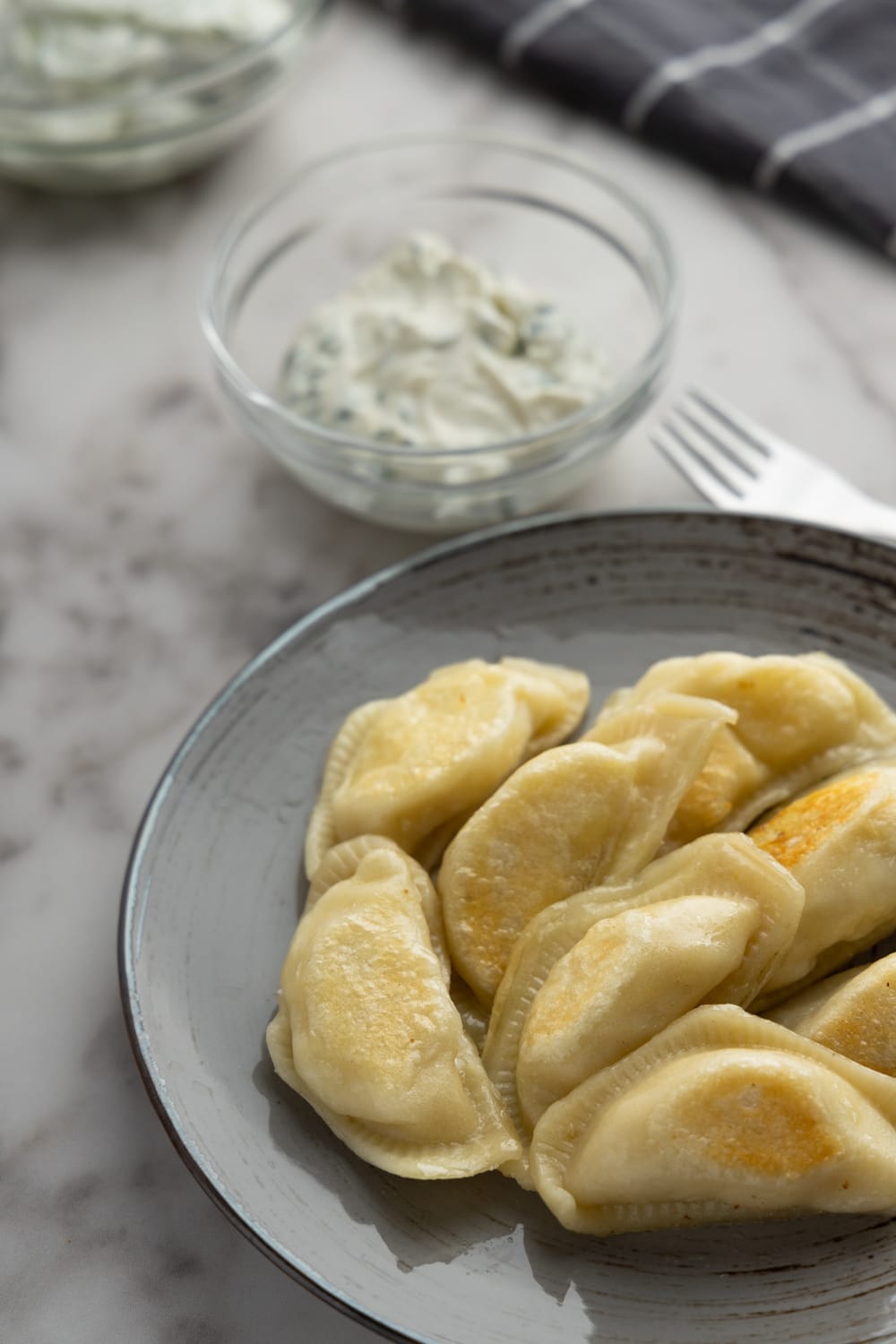Potato and Cheese Pierogi (Pierogi Ruskie)
This post may contain affiliate links. Read our privacy policy.
Get ready to indulge in the deliciousness of traditional Polish potato and cheese pierogi. This recipe offers three cheese options, including the classic farmer’s cheese, cream cheese as a flavorful alternative, and cheddar as a slightly different but still quite popular option.
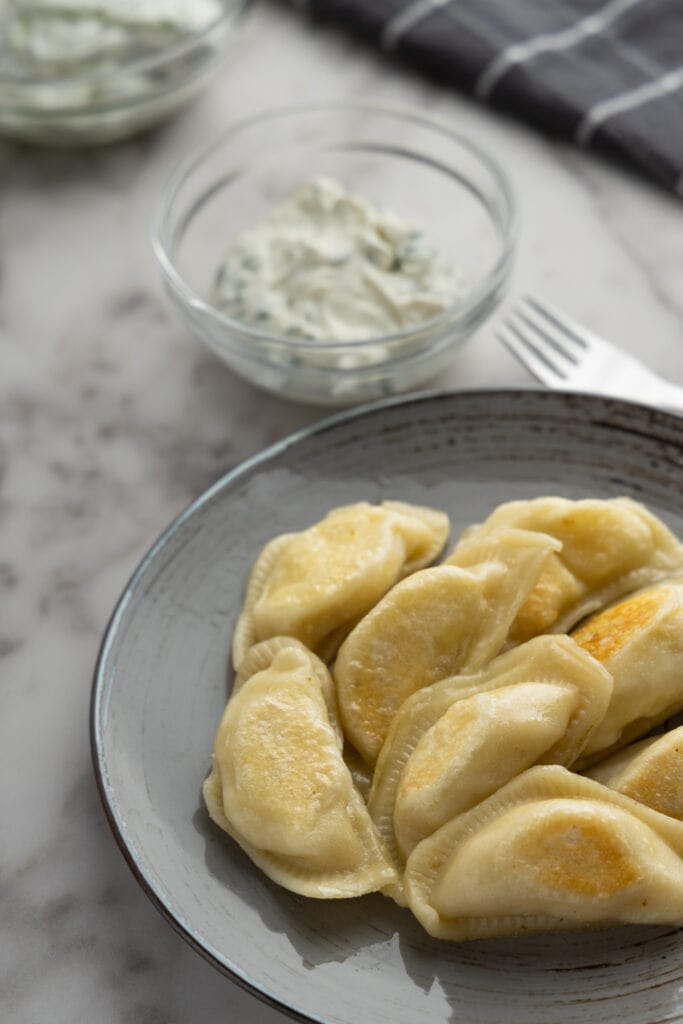
When we Poles think about cheese in our pierogi, we’re almost always talking about farmer’s cheese (or quark). It’s like a best friend to the pierogi lover here, easily found and just perfect for the dish, especially for potato and cheese pierogi.
But hey, I get that farmer’s cheese might be playing hard to get outside Eastern Europe, so I’ve got your back with a tasty alternative. Cream cheese is the next best thing I found, and it fits the pierogi bill with its delicious taste and texture.
(Oh, and by the way, cream cheese rocks in sweet cheese pierogi too!)
Now, if you’re feeling adventurous, you could even try cheddar. It dances to a different beat with a flavor that’s quite different from farmer’s cheese or cream cheese. But you know what? It’s quite popular online, so I’m going to tell you how to pull that off as well.
Alright, enough chit-chat. Let’s roll up our sleeves and dive into the recipe!
Recipe At a Glance
Ready to explore why this potato and cheese pierogi (or pierogi ruskie) recipe is calling your name? Here’s why you’ll love it:
- It’s a classic. Potato and cheese in a pierogi? It’s like bread and butter; you can’t go wrong. Always in the top three when someone chats about pierogi fillings. This duo has been dancing on plates for decades, and it’s still a hit.
- Simple ingredients. All you need for the filling is mashed potatoes and either farmer’s cheese, cream cheese, or cheddar. The shopping list’s shorter than a winter day, and odds are you’ve got everything you need right in your kitchen.
- Perfect for freezing. Feel like playing it smart? Double or even triple the batch and tuck some away for later. Talk about a time-saver!
Now, if you’re a potato and cheese pierogi newbie, make sure to give the ingredients notes, step-by-step instructions, and tips a good read. But if you’re already a pierogi pro, feel free to jump straight to the recipe card.
Extra Learning
Before we jump in, here are a few handy resources to help you nail this recipe:
- Homemade Pierogi for Beginners. My pierogi guide that walks you through the pierogi making process, start to finish. Whether you’re new to pierogi or just need a refresher, this guide has you covered.
Ingredients Notes and Substitutes
Pierogi Dough
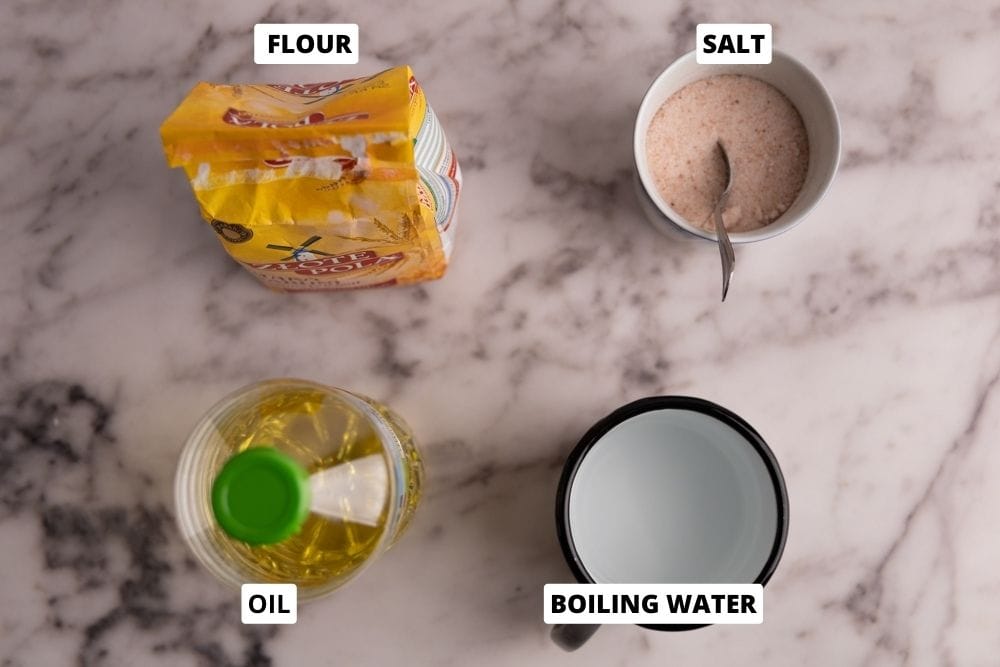
- Flour. Use all-purpose flour. If you use something like bread flour or whole wheat flour, you will need noticeably more liquid to achieve the right dough texture.
- Oil. Use a neutral-flavored oil, such as your regular cooking oil. Avoid olive oil as it can be bitter, which may affect the dough’s flavor.
- Salt. Use fine-grained salt for best results.
- Water. Plain boiled water is all you need; no need to be fancy here.
Potato and Cheese Pierogi Filling
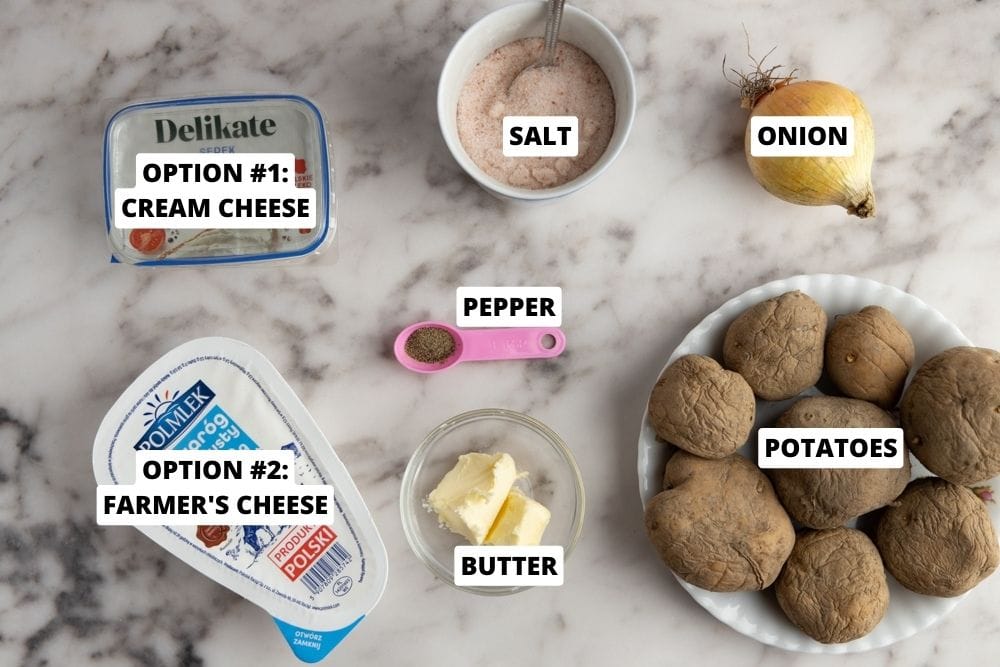
- Potatoes. Yellow-fleshed potatoes like Yukon Gold are probably best because they turn out dense and creamy, but any other potatoes you use for mashing will work just fine.
- Farmer’s cheese or cream cheese. Either works perfectly fine. If you’re buying cream cheese, make sure you go with regular cream cheese, not cream cheese spread. Cheddar cheese yields a different flavor but is also an option. If you want to go with cheddar, read the section below that covers this variation.
- Onion. Yellow onion is the golden standard, but subbing in a red onion, a couple of shallots, or even bulbs of green onion will be fine, too.
- Butter. Use regular, unsalted butter, please.
- Salt. You’ll need some table salt for cooking the potatoes and pierogi.
- Pepper. Regular black pepper is all you need.
Step-By-Step: How to Make Potato and Cheese Pierogi
Step 1: Make Dough
(Read more about this in our no egg pierogi dough recipe.)
- Boil a pot of water.
- Sift flour into a large bowl. Sifting probably isn’t necessary, but I recommend it anyways. Plus, it’s something you can do while waiting for the water to boil.
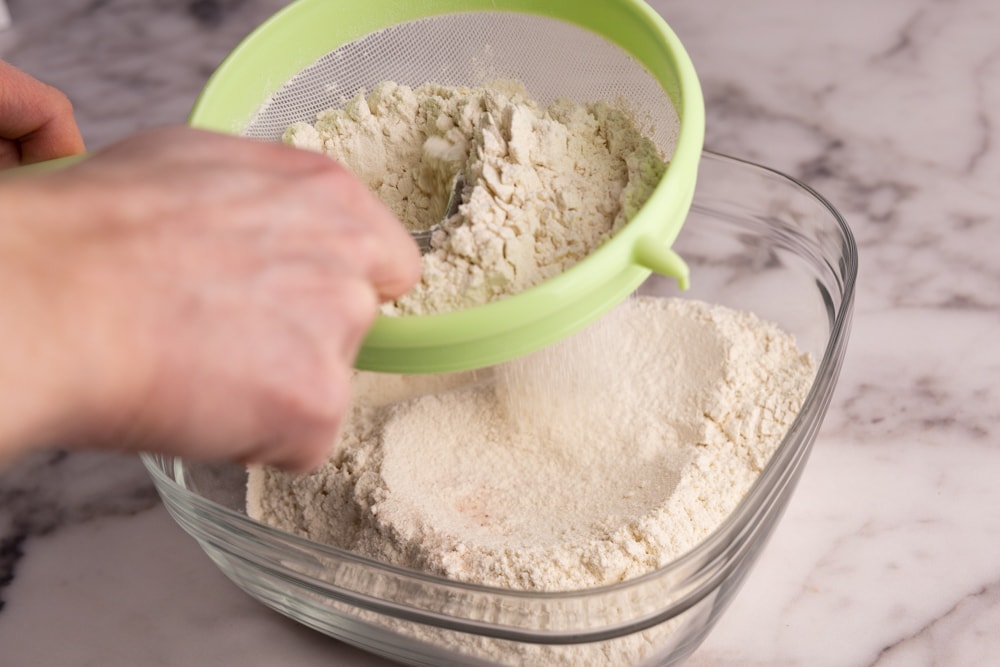
- Add salt and mix. Just a quick stir to spread the salt.
- Add oil and boiled water.
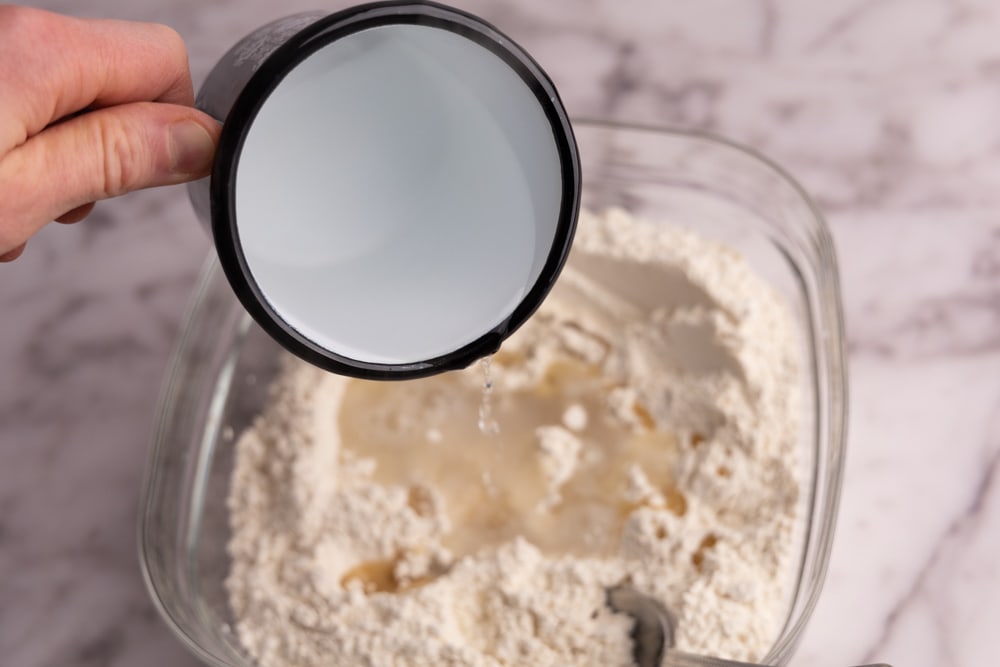
- Mix. Mix the ingredients by stirring with a regular tablespoon or a large wooden spoon. Be careful not to burn yourself, as you will be working with water that was boiling just a few moments ago. Stir until you reach the point where there is no visible water in the bowl, then switch to using your hands.
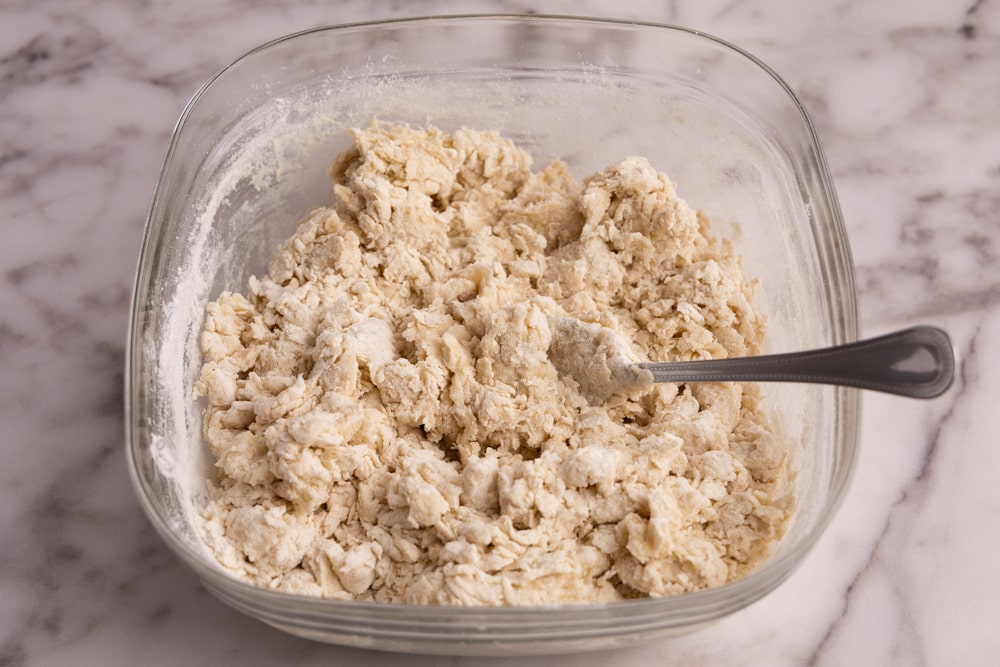
- Knead. Start slowly and make sure the dough isn’t too hot to handle. Knead until you have incorporated all the flour into a homogeneous dough ball, which usually takes 4 to 8 minutes.
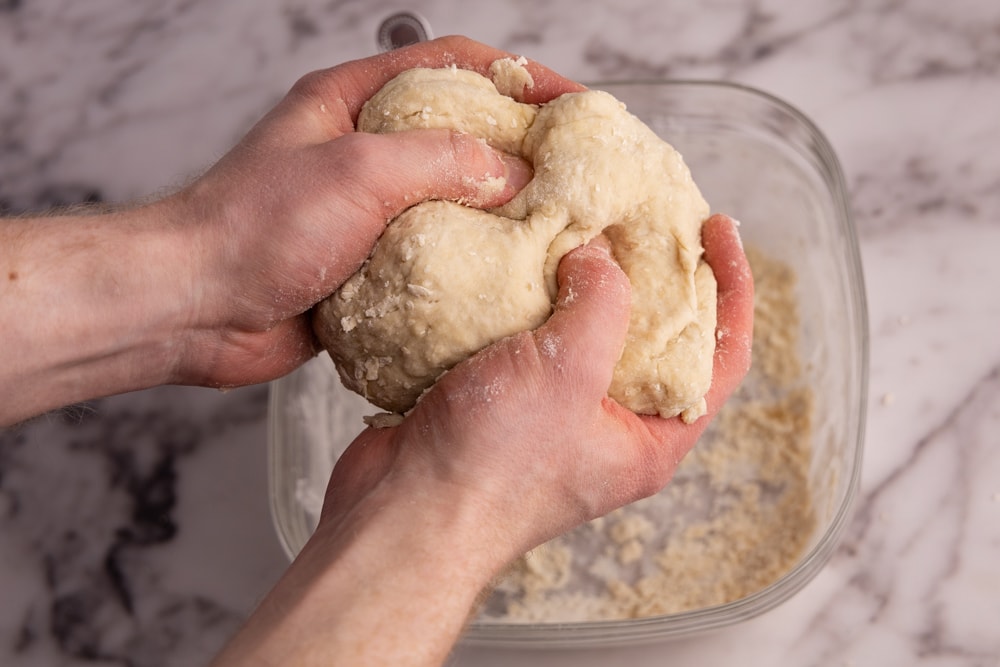 Kneading in progress. Note that there’s still flour left in the bowl.
Kneading in progress. Note that there’s still flour left in the bowl.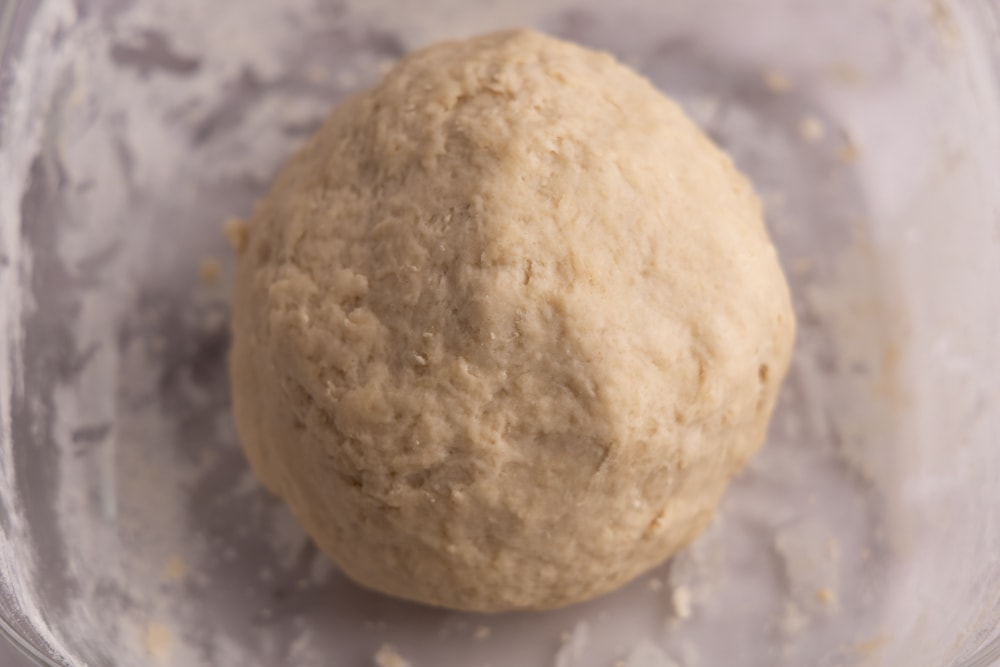 Dough ready – all the flour is incorporated and the dough is pretty homogenous.
Dough ready – all the flour is incorporated and the dough is pretty homogenous.
- Wrap and rest. Wrap the dough ball tightly in plastic wrap and let it rest for about 30 minutes before continuing. This will allow the dough to relax and become easier to work with.
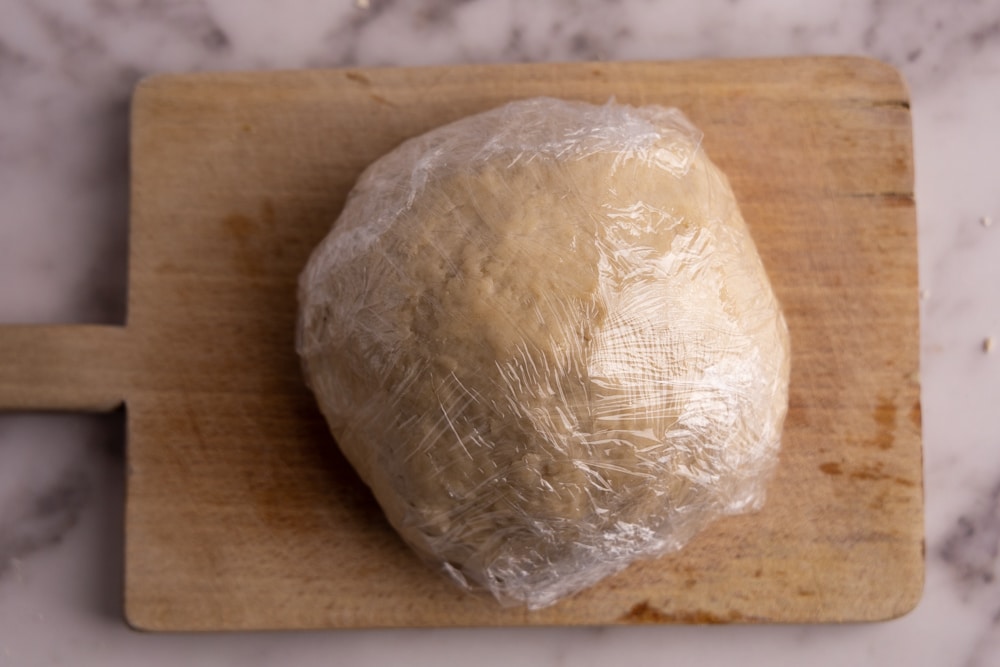
- Make pierogi. Once that half an hour of waiting is over, the dough is ready for rolling and making pierogi.
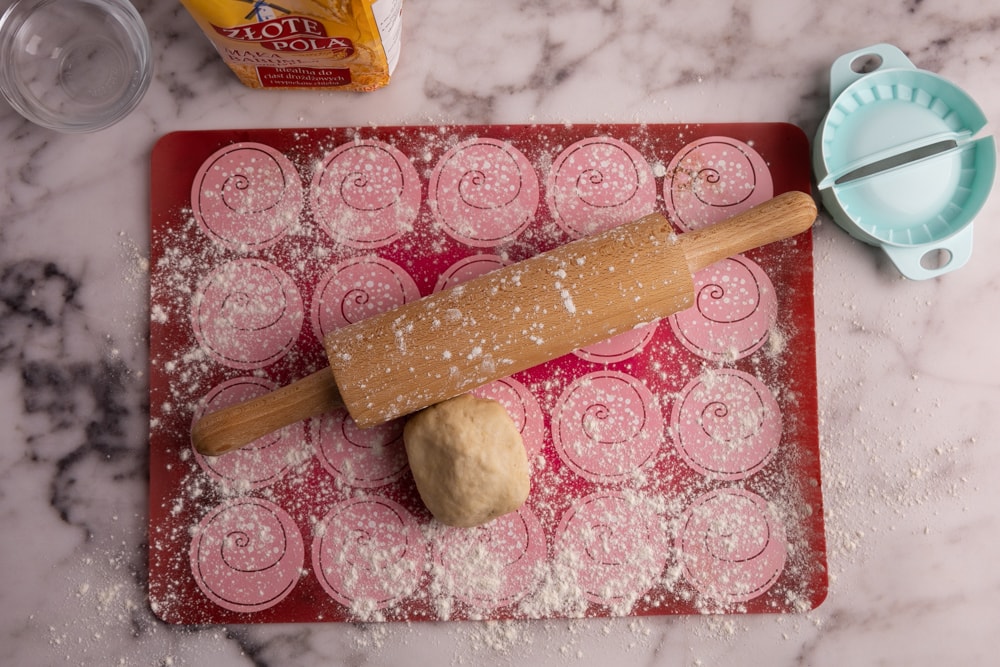
Step 2: Prep Filling
- Cook the potatoes. Peel and chop those spuds into quarters, then give them a good boil in heavily salted water for about 20 minutes or until you can easily pierce them with a fork.
- Sauté the onion. While the potatoes are cooking, peel and finely chop the onion. Heat some oil (or butter) in a non-stick skillet over medium heat, then add the onion and sauté until soft and translucent, about 6 to 10 minutes. Remove from heat and set aside.
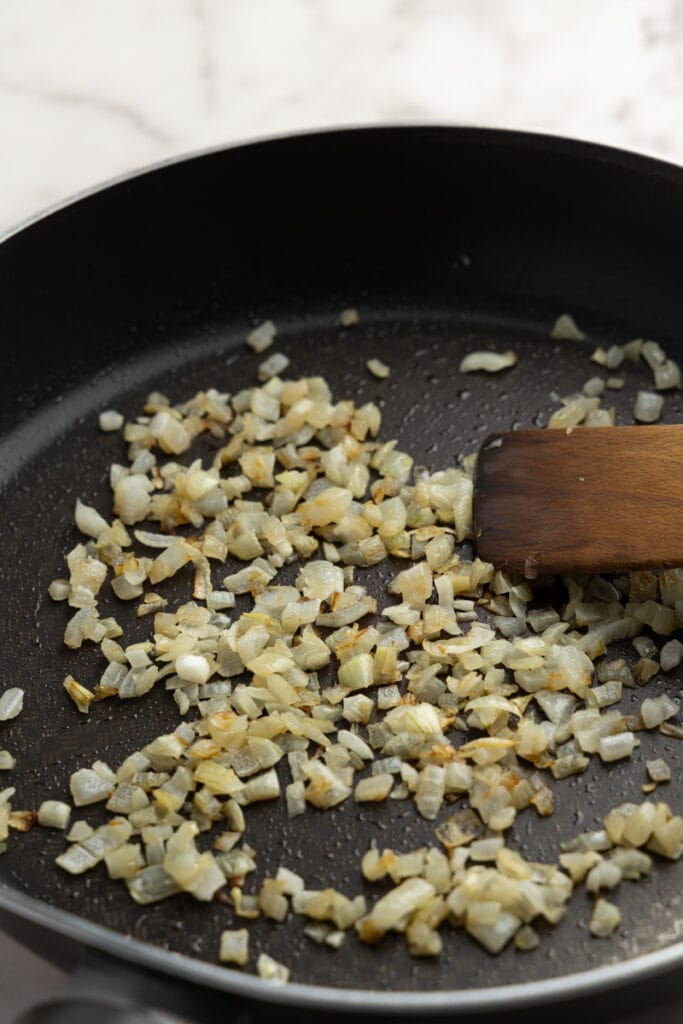
- Mash the potatoes. Drain the cooked taters, then mash them using a potato masher or a fork until smooth. Add butter and maybe a dollop of sour cream, but hey, don’t go wild! We want flavor, not a potato soup. Stick to the script.
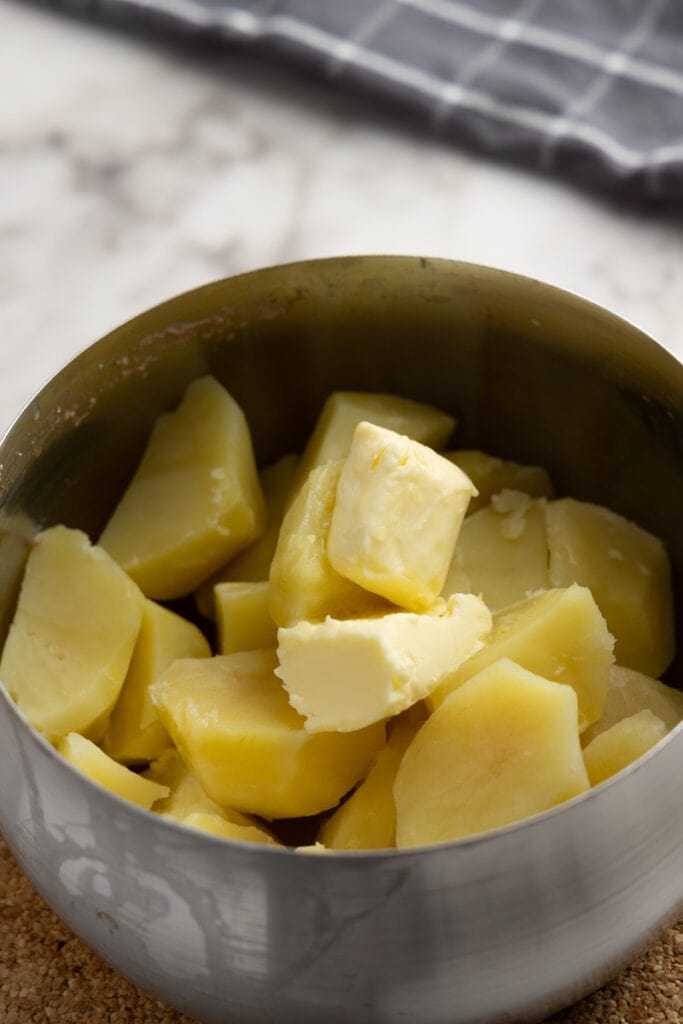
- Make the filling. Combine the mashed potatoes, sauteed onion, pepper, and your cheese of choice in a large bowl, and give it a good stir. Taste and adjust the seasoning as needed. Lacks flavor? It could likely use more salt. No tanginess? A squirt of lemon juice or an extra teaspoon of sour cream should help.
 Add ingredients
Add ingredients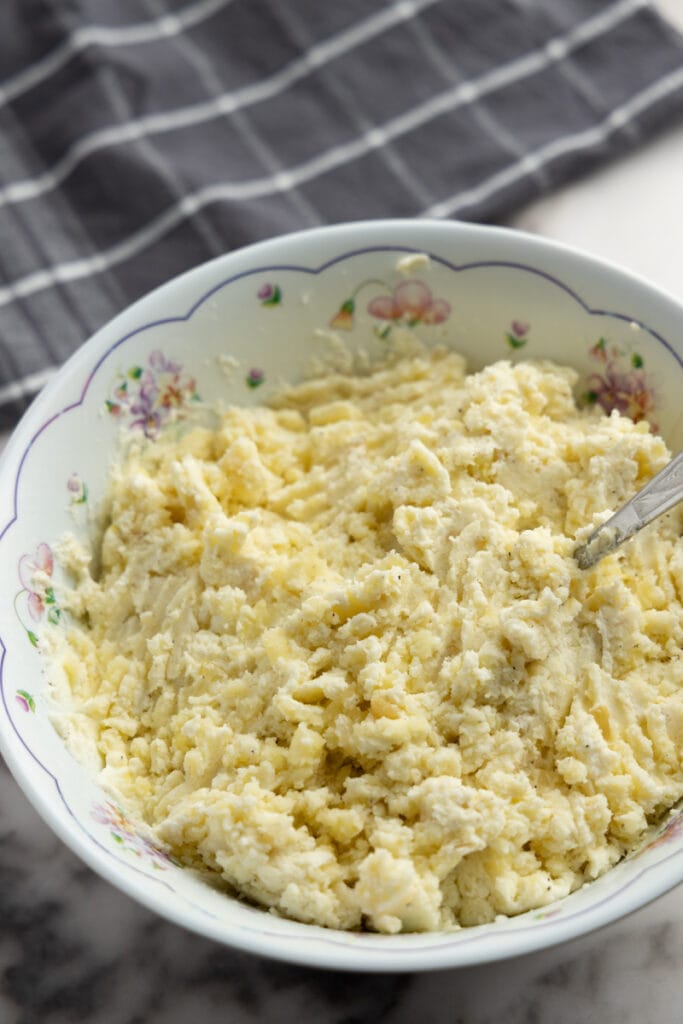 Combined
Combined
Step 3: Combine
- Divide. Divide the pierogi dough into two or three parts. Take one part and spread it on a floured work surface, then roll it out until it’s nice and thin. Be careful not to roll it too thin, as it may tear when you form the pockets and seal the dough around the filling. Wrap the rest of the dough tightly to prevent it from drying out.
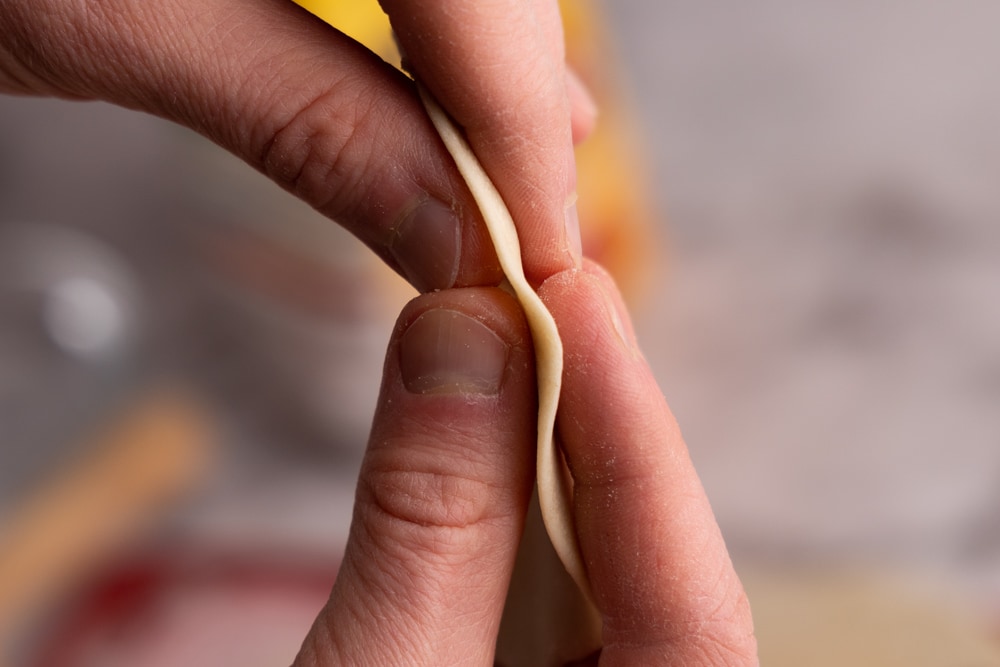
- Cut into circles. Cut palm-sized circles in the rolled pierogi dough. Anything round with a somewhat sharp edge is great, but a simple glass or mason jar works as well. Or use your pierogi maker if you have one. Form a ball with the dough left over after cutting and use it when rolling out the rest of the pierogi.
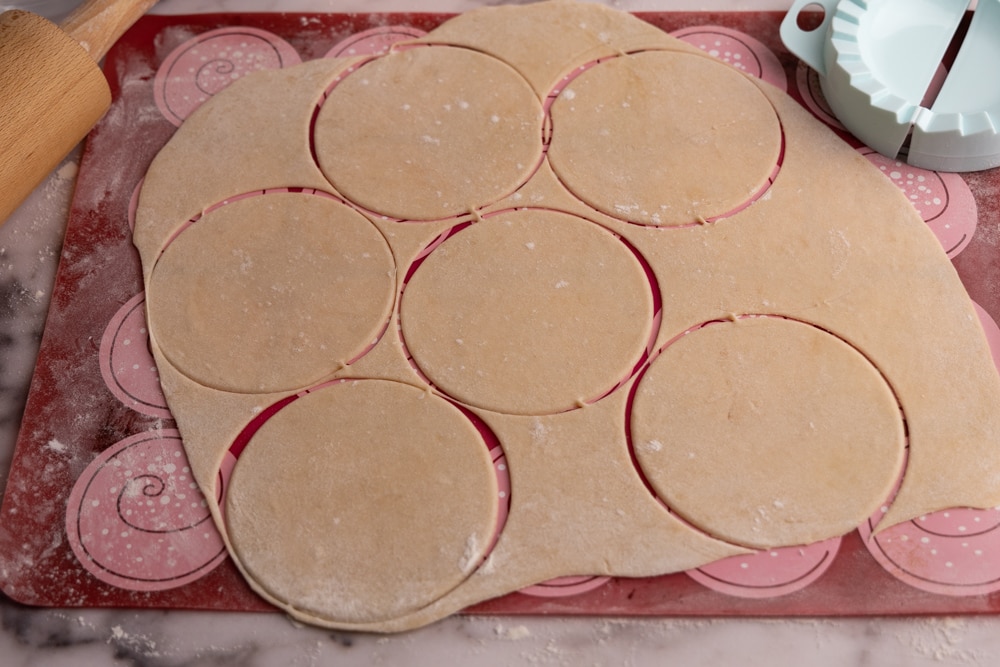
- Fill dough. Place a spoonful of the filling in the middle of the dough circle, then fold the dough over the filling and press the edges together starting in the middle. Try to leave as little air as possible in the pocket you’re forming. To make a good seal, moisten the outer edge of the dough using a wet finger before pressing the edges together.
- Cover with damp towel. Place each formed pierogi on a floured cookie sheet and cover them with a damp kitchen towel. The edges will dry out quickly otherwise. If you want to save space and let the pierogi touch each other, lightly brush the areas where they’ll touch with flour. This will prevent them from sticking together and causing the pierogi dough to tear when removed for boiling.
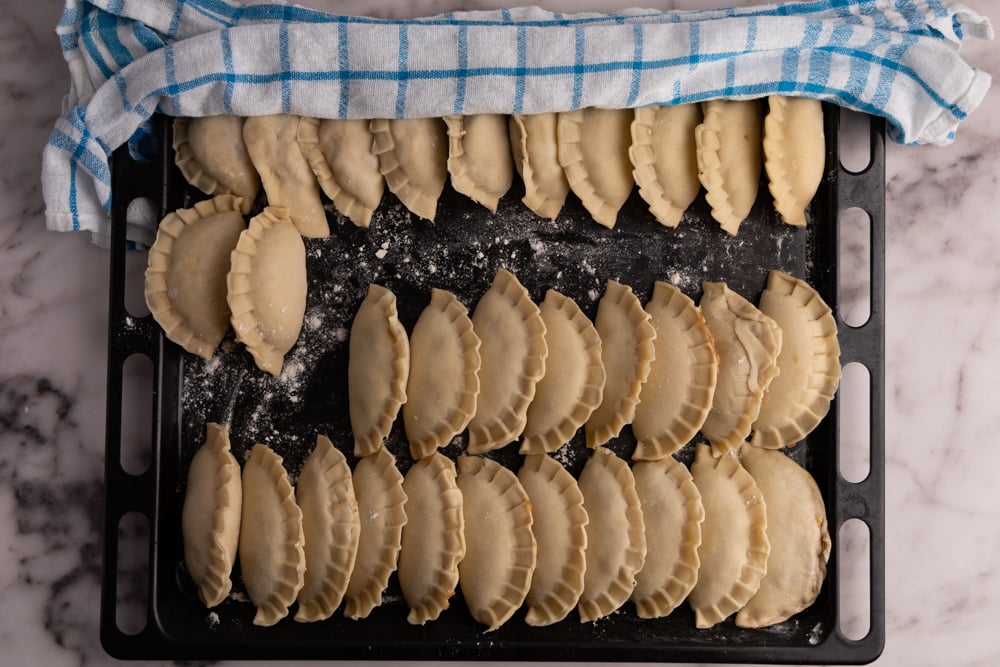
- Make more pierogies. Continue forming pierogi until you run out of dough or filling.
Step 4: Cook
- Boil water. Bring a large pot of salted water to a boil. I typically use one teaspoon of salt per quart of water but feel free to adjust the amount to your preferences.
- Add a few pierogi. Once the water is boiling, add a few pierogi to the pot and stir them to prevent them from sticking to the bottom. Once the pierogi start floating to the surface, simmer them gently for another 3 to 4 minutes. Make sure not to overcrowd the pot so that the pierogi don’t stick together or cook unevenly.
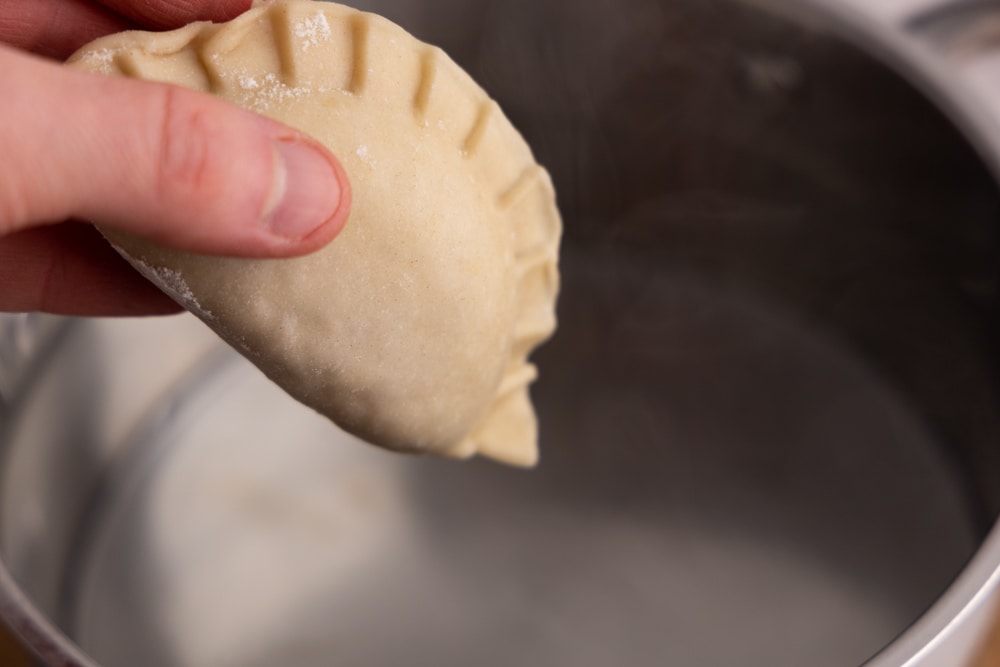
- Remove and serve. Remove the pierogi from the water using a slotted spoon and serve.
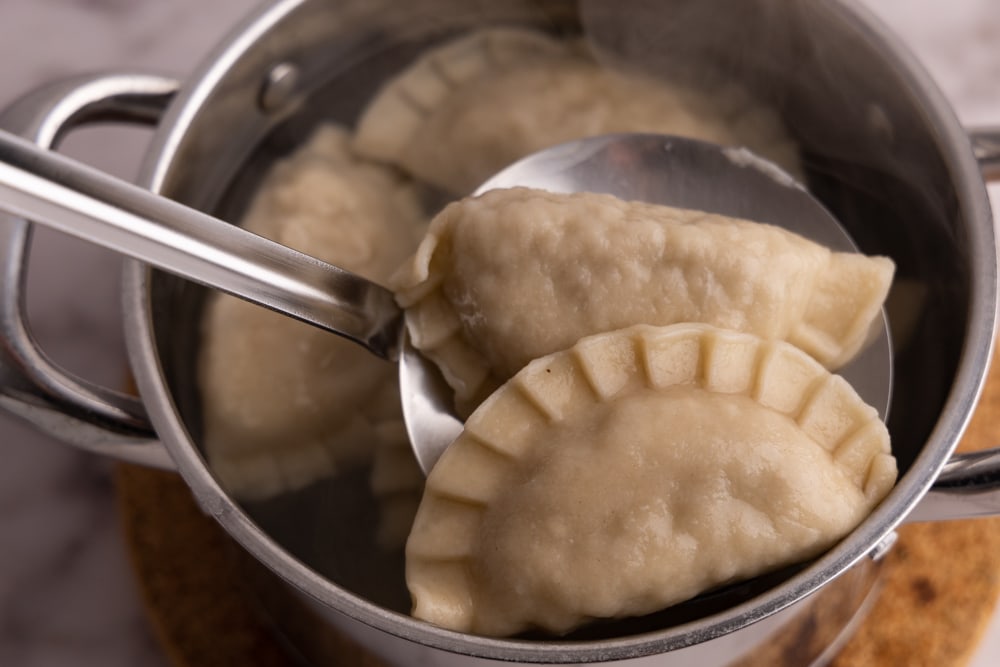
Cheddar Cheese Variation
So you’re thinking about going rogue with some cheddar in your potato and cheese pierogi? Bold move.
Cheddar brings its own salty swagger, kind of like mashed potatoes with a bit more attitude. But be warned, it lacks that traditional tanginess potato and cheese pierogi are known for (at least in Poland).
Think of it as another variation, not a stand-in for farmer’s cheese or cream cheese.
(I love potatoes and farmer’s cheese or cream cheese, but hey, I’ve heard whispers of people out there rocking the potato and cheddar combo.)
Ready to give it a whirl? Let’s break it down:
- Easy on the cheddar. Cheddar’s got a big personality, so let’s keep it in check. Around 2 to 3 oz of grated cheddar for 4 medium-sized potatoes will do. Pile on more, and you’ll get a sharp and salty mash – interesting, but maybe not what you’re after.
- Hot potato mix. Stir that cheddar into your mashed potatoes while they’re still hot. This allows the cheese to melt and spread more evenly throughout the filling, creating a smooth and well-integrated texture.
- Missing some zing? Cheddar can be a little one-note, so if you’re missing the tang, grab some sour cream or lemon juice. Start with a spoonful or a squirt, taste, and adjust. You want a hint of zing, not a full-on zing attack. Of course, if you’ve found your groove with just potatoes and cheddar, feel free to skip the acid. It’s your kitchen, your rules.
Cheddar might be an unconventional choice for traditional Polish potato and cheese pierogi, but it’s a pretty popular stand-in worldwide, so it’s definitely worth a shot.

How to Serve
To serve Potato and Cheese Pierogi, you have a few delicious options:
- Enjoy them as is: These pierogi are already fantastic on their own, so you can serve them as the main meal, the star of the show. Simply plate them up and let everyone dig in.
- Pan fry for extra deliciousness: If you want to take the pierogi to the next level, pan frying is the way to go. Grab a nonstick skillet, melt a knob of butter or a bit of oil, and cook the pierogi for a few minutes on each side until they turn crispy and golden brown. The added texture is simply delightful.
- Top with melted butter: For an extra indulgent touch, you can top the pan-fried pierogi with melted butter. Just pour it all over the pierogi before serving. The rich and creamy butter will enhance the flavors even more.
- Serve with sour cream: Now, here’s a classic – a dollop of sour cream. It’s tangy love that pairs so well with the cheesy filling. You can get fancy and mix in chives, salt, and pepper if you like. (I did just that for my photos, and it looked stunning!)
- Pair with a salad: Looking for some fresh vibes? Pair your pierogi with a Polish salad. Maybe a cucumber salad, sauerkraut salad, or a simple tomato salad? It’ll make your meal sing with Polish flair.
Wondering what else you could throw into the mix? Check out our article on pierogi toppings to find even more inspiration.
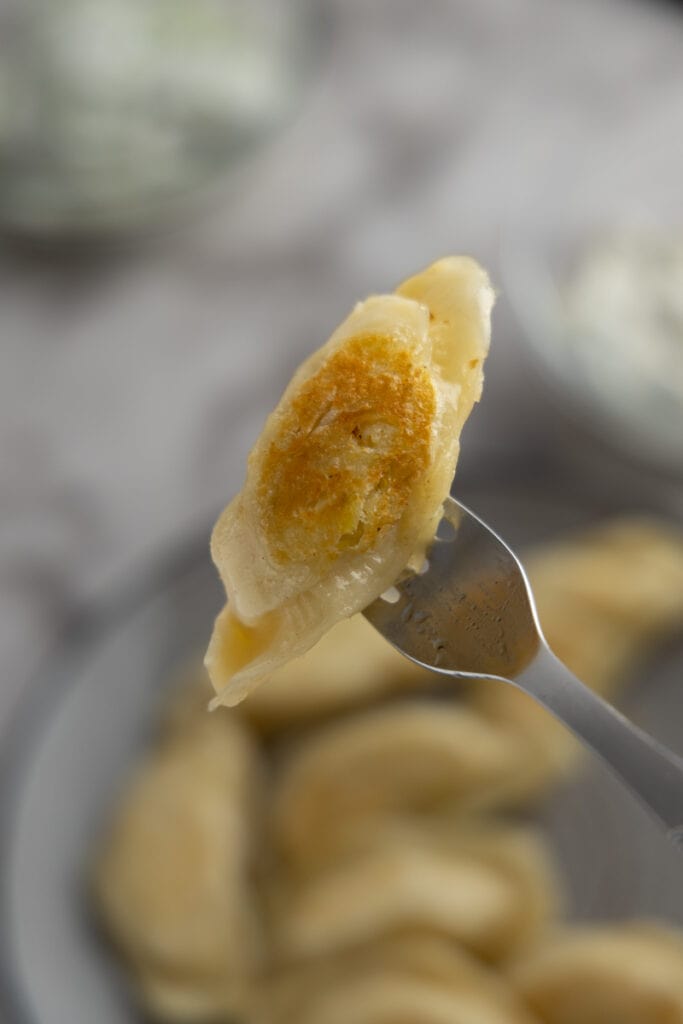
Storage
So you’ve made a big, beautiful batch of potato and cheese pierogi, and now you’re staring at leftovers? Fantastic!
Leftovers mean you get to enjoy them all over again, and here’s how you can make sure your leftover potato and cheese pierogi stay fresh and ready for round two:
- Let them Breathe: Start by laying your pierogi out on large plates. Give them 10 to 20 minutes to dry a bit, then flip them for another 10 to 15 minutes. You want them dry so they don’t cling to each other in the storage container.
- Snug but not squished: Time to pack them up! Transfer your pierogi into an airtight container. Be gentle, place them in a single layer, and avoid crowding. If they need to be stacked, put some plastic wrap between layers to prevent them from sticking.
- Chill or freeze: Seal that container tightly and pop it into the fridge for 3 to 4 days. If you need more time, the freezer’s your friend. Here’s my article on how to freeze pierogi.
How to Reheat
To reheat Potato and Cheese Pierogi, the best method is to pan-fry them. This not only warms them up but also adds a delightful crispy texture to the pierogi.
Here’s a step-by-step guide on how to do it:
- Grab a nonstick skillet and place it over medium heat on your stovetop.
- Add a knob of butter or some oil to the skillet, making sure it covers the base of the pan. You can use either butter or oil, depending on your preference. Warm the fat nice and hot.
- Once the skillet is ready, carefully lay the pierogi into the pan. Make sure not to overcrowd the skillet, as this can affect the cooking process.
- Let the pierogi cook for around four to six minutes on the first side. You want them to become golden brown and crispy.
- Using a spatula, carefully turn the pierogi over to cook the other side. Continue cooking for another four to six minutes until both sides are equally golden brown, warm, and crispy.
- Once the pierogi are ready, remove them from the skillet and serve them.

Equipment
Ingredients
Pierogi Dough
- 2 cups all-purpose flour ~250g
- ¼ tsp salt
- 1 ½ tbsp oil
- ½ cup boiling water ~120ml
Potato and Cheese Pierogi Filling
- 4 medium-sized potatoes about 1 pound or 450 grams
- 7 oz farmer’s cheese or cream cheese about 200g
- 1 medium onion
- 1 tablespoon butter
- 1/4 teaspoon pepper
- 1 tablespoon sour cream optional
- salt for cooking
Instructions
Make Dough
- Boil Water: Boil a pot of water.½ cup boiling water
- Sift Flour: Sift flour into a large bowl.2 cups all-purpose flour
- Add Salt: Add salt and mix.¼ tsp salt
- Wet Ingredients: Add oil and boiled water.1 ½ tbsp oil
- Mix Ingredients: Mix the ingredients by stirring with a spoon. Be careful not to burn yourself. Once there is no visible water in the bowl, use your hands to knead the dough until it is a homogeneous ball.
- Wrap and Rest: Wrap the dough ball tightly in plastic wrap and let it rest for about 30 minutes before continuing.
- Make Pierogi: Once the wait is over, the dough is ready for rolling and making pierogi.
Prep Filling
- Cook Potatoes: Peel, quarter, and boil potato in salted water until fork-tender.4 medium-sized potatoes
- Sauté Onion: Chop and sauté in oil or butter until soft. Remove and set aside.1 medium onion
- Mash Potatoes: Drain, mash, and mix in butter and optional sour cream (mind the texture!).1 tablespoon sour cream, 1 tablespoon butter
- Make Filling: Mix mashed potatoes, sautéed onion, pepper, and cheese. Adjust seasoning if needed.1/4 teaspoon pepper, 7 oz farmer’s cheese or cream cheese
Combine
- Roll Out Dough: Divide the pierogi dough into two or three parts. Then, spread one on a floured work surface and roll it out until it's thin. It shouldn't be super thin so that you can still stretch it when forming the pockets.
- Cut Dough: Cut palm-sized circles in the rolled pierogi dough using a cookie cutter or glass.
- Fill: Place a spoonful of filling in the center of each dough circle. Fold the dough over the filling and press the edges together, starting in the middle. Leave as little air as possible in the pocket you're forming. To help form a good seal, moisten the outer edge of the dough using a wet finger.
- Store: Place each formed pierogi on a floured cookie sheet and cover them with a damp kitchen towel.
Cook
- Boil Water: Bring a large pot of salted water to a boil. I typically use one teaspoon of salt per quart of water but feel free to adjust the amount to your preferences.
- Cook: Once the water is boiling, add a few pierogi to the pot and stir them to prevent them from sticking to the bottom. Once the pierogi start floating to the surface, simmer them gently for another 3 to 4 minutes. Make sure not to overcrowd the pot so that the pierogi don't stick together or cook unevenly.salt
- Serve: Remove the pierogi from the water using a slotted spoon and serve immediately with your favorite toppings.

